Bella Umbria!
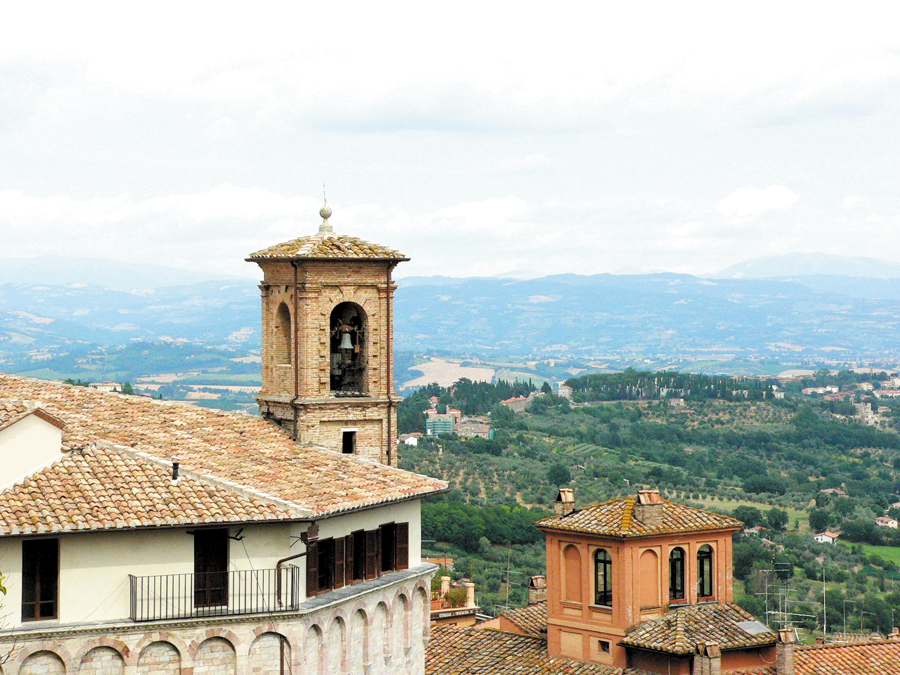
Umbria Landscape
When considering the many possible summer vacation destinations, it’s easy to make the case for Italy. Everything about the choice is a winner: the weather, the historic architecture, the food, and, of course, the music, if you choose Perugia, Italy. For years I’ve heard enthusiastic reports about the annual summer trip a contingent of faculty members make to Perugia, Italy, for clinics and performances at the Umbria Jazz Festival. To mark the 20th anniversary of Berklee’s affiliation with the festival this year, I made the trip and found that the event and the old-world charm of Perugia are everything they’d been cracked up to be.
Even the flight was pleasant—especially the last leg of the journey from the United States, which offers a panoramic view of quintessentially European geography. As the sun rose toward the end of my overnight flight, I peered out the window to see the multicolored quiltlike farmlands of France. There was an anachronistic contrast between medieval castles standing idly atop hills and nuclear power plants puffing steam in verdant valleys. The entire vista was transformed abruptly by the appearance of the perennially snowcapped Alps that separate Switzerland and the Italian peninsula from the rest of the European continent. In approaching Rome’s Fiumicino Airport, our flight path afforded a view of both the Mediterranean and Adriatic seacoasts, their jade-colored waters dotted with tiny white boats and golden sand beaches. Once on the ground, I took a short ride on the airport tram, which brought me most of the way to a rail station inside the airport. From there, it was an idyllic two-and-a-half-hour train ride to Perugia. We chugged alternately through sleepy villages with tall, stucco homes topped with red tile roofs, sun-blanched hayfields, acres of glowing sunflowers, and the occasional pasture of grazing farm animals.
When I stepped out at Perugia Station, I was struck by how seamlessly the best of new and old Europe blend together. The modern urban infrastructure—buses, traffic signals, apartment buildings, and gas stations—is juxtaposed with the quaint, old-world architecture of Perugia’s 2,700- year-old Centro (city center) atop a hill. Each July since 1973, musicians from near and far have converged in Perugia for the immensely popular Umbria Jazz Festival. The 10-day music series produces events in diverse concert venues ranging from ornate eighteenth-century opera houses to huge outdoor stages. It’s a memorable ascent on foot from the Arena Santa Giuliana (where the largest concert attractions play) to the Piazza Italia, the gateway to the other music venues.
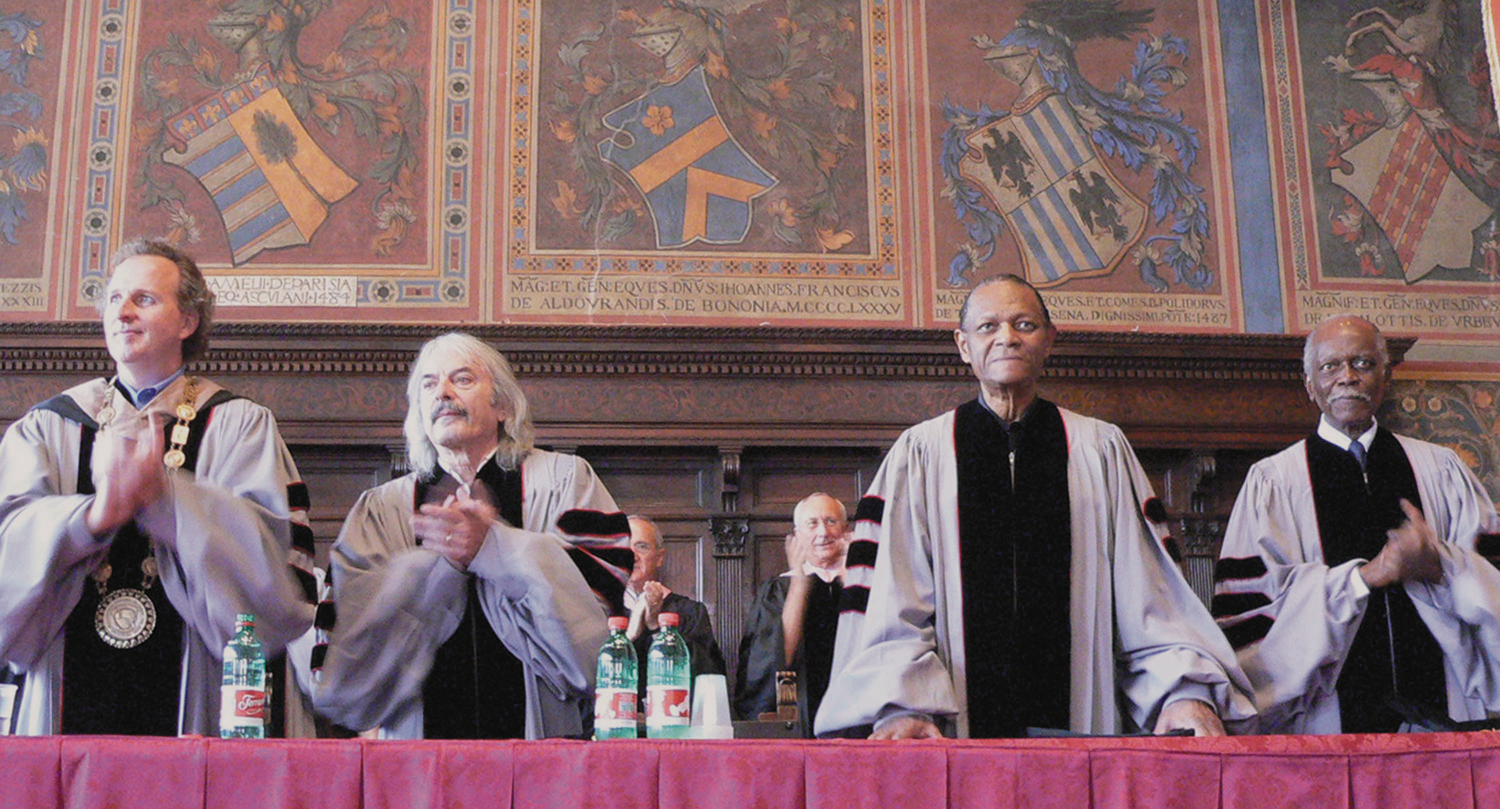
From the left: President Roger Brown and honorees Enrico Rava, McCoy Tyner, and Hank Jones at Sala Dei Notari.
Concertgoers file elbow-to-elbow through the underground Rocca Paolina’s winding catacombic brick passages with high, vaulted ceilings up a twisting series of sloping inclines, stairways, and escalators to emerge on the piazza near the upper end of the Corso Vannucci. There, the air is alive with strains of buskers competing for pocket change playing all manner of music and the echoes from the main stage on the Piazza IV Novembre at the far end of the Corso. Music ricochets up the shop-lined Corso, bouncing off the walls of centuries-old four- and five-story brick buildings. The backdrop to the Piazza IV Novembre stage is the imposing Cathedral of San Lorenzo (completed in the sixteenth century) while at stage left is the softly bubbling Fontana Maggiore (from the thirteenth century). From noon until the wee hours of the morning, the Corso is thronged with many thousands of music fans who’ve come to hear the offerings of a range of stylists serving up traditional and contemporary jazz, Dixieland music, and Euro jazz, as well as pop, r&b, and gospel fare. Among this year’s big-name artists were George Benson, Elton John, McCoy Tyner, Tony Bennett, Diana Ross, the Joe Lovano-Hank Jones Quartet, Brad Mehldau, Jim Hall, the Mingus Big Band, Eumir Deodato, and Enrico Rava, to name a few.
Berklee alumni and faculty members were playing with numerous festival acts. Among the many were Kenya Hathaway ’95 singing backup with George Benson’s group, Associate Professor Kenwood Dennard drumming for Delmar Brown’s band Total Victory, guitarist Mark Whitfield ’87 playing with organist Dr. Lonnie Smith, saxophonist Greg Osby ’83 in a trio with guitarist Charlie Hunter and drummer Bobby Previte, and vocalist Chiara Civello ’98 whose entire band was made up of alumni. Berklee’s own Donna McElroy-Larry Monroe Band, 11 members strong, played five nights on the big stage at Piazza IV Novembre.
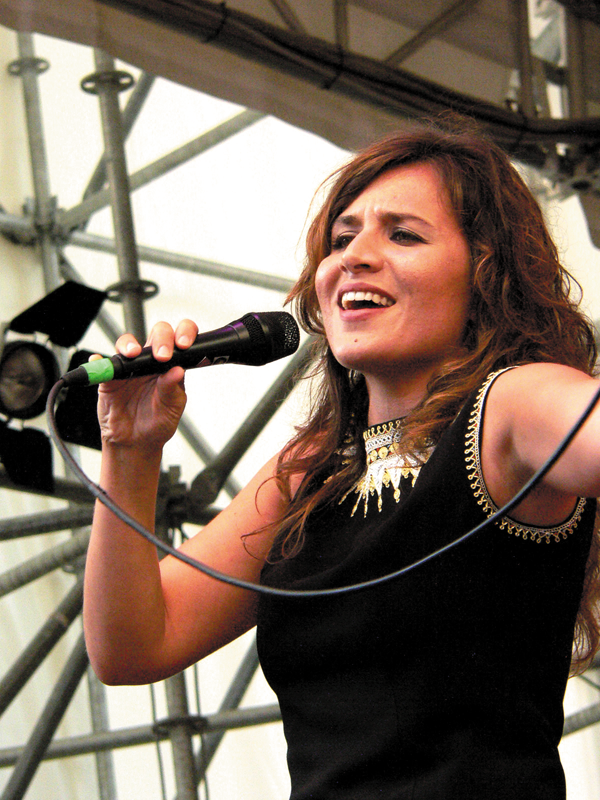
Chiara Civello ’98 was a featured artist at Umbria Jazz 2005.
A lot of other Berklee folk were on hand this year, too. In addition to Berklee’s Associate Vice President for International Programs Larry Monroe, 10 faculty members, and support staff, President Roger Brown and his wife Linda Mason made the journey with Berklee Board of Trustees members Allan McLean (board chair) and Alan Reese and their respective spouses Mary Ann and Cam. Friend of the college Collette Delerue flew in from Paris to join the troupe.
I joined President Brown and his party in the open-air restaurant of the fabled La Rosetta Hotel where many festival musicians stay. Their table was a hub of activity as dozens of alumni and faculty paused to chat before heading off to their gigs. Kenwood Dennard (who has worked with Jaco Pastorius, Gil Evans, Sting, Wayne Shorter, Whitney Houston, and others) brought several people by, including Fred Wesley (former James Brown trombonist) and guitarist Mark Whitfield. After dinner, it was off to Teatro Morlacchi for McCoy Tyner’s midnight show.
The next morning at 11:00 A.M. in the magnificent thirteenth century town hall Sala Dei Notari, President Brown awarded honorary doctorates to jazz piano giants McCoy Tyner and Hank Jones and Italian trumpet master Enrico Rava for their contributions to jazz and to celebrate Berklee’s 20-year involvement in the festival. The cavernous room with its dark wooden paneling and ornate frescoed arches and walls barely contained the enthusiastic crowd that included the whole Berklee crew and numerous music fans who gave thunderous standing ovations to each honoree. Later, in the heat of the afternoon, the 230 students of this year’s Berklee Summer School at Umbria Jazz Clinics marched in a parade on the Corso to mark the 50th year since Charlie Parker’s passing. The event also served to let everyone know that Berklee has an enduring presence at the Umbria festival.
It was back in 1986 that Berklee first presented clinics in Perugia. The three men who have facilitated Berklee’s participation are Italian impresario and festival director Carlo Pagnotta, assistant director Giovanni Tommaso (also one of Italy’s top jazz bassists), and Sauro Peducci, who is the director of organization for the festival and clinics. The Berklee clinics went so well that the tradition continued. “Gary Burton and I originally created the concept for these one- to two-week programs in a hotel room in Tokyo,” says Larry Monroe. “We ran them successfully in Tokyo and Barcelona in 1985. When Carlo Pagnotta got wind of what we were doing, he invited us to his festival the next year.
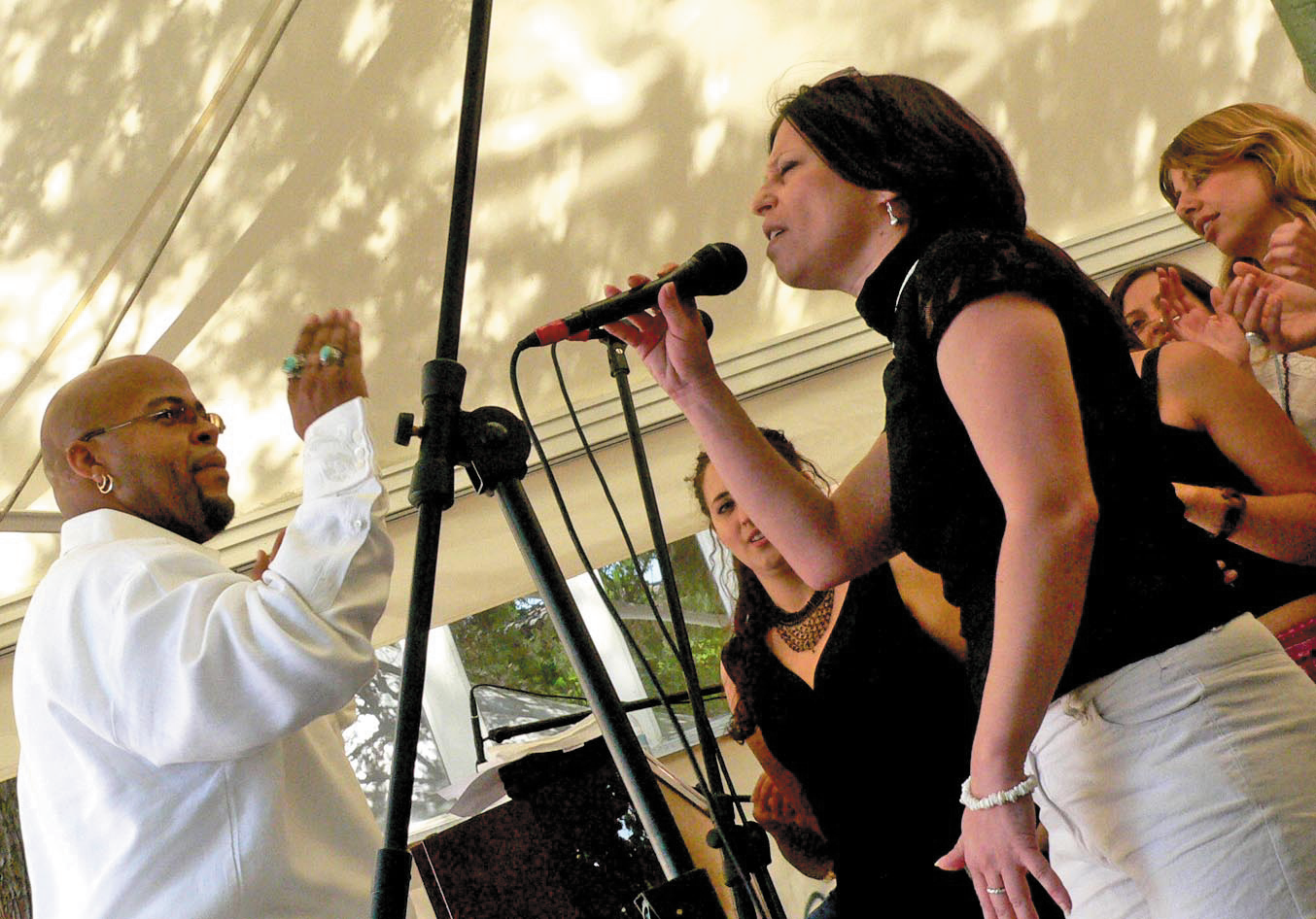
Dennis Montgomery leads his student gospel choir in the final performance of Berklee’s Umbria Jazz 2005 clinics.
“It takes a special kind of faculty member to succeed in this setting,” Monroe continues. “Since the program is short, the teachers need to be able to connect with the students right away. They must have the stamina to teach longer hours than they do in Boston and then, after a quick change of clothes, appear on a big stage at a major jazz festival.”
Monroe sees the clinics as much more than a student-recruiting effort for Berklee. “We are teaching the elements of jazz to these kids,” he says. “After class, they go to hear major performers and return the next day, saying, ‘You were right. I saw so-and-so play last night and heard him using the diminished scale.’ It’s a two-week immersion in Berklee’s methods in a beautiful European setting.”
Among the faculty who regularly make the trip, Guitar Professor Jim Kelly holds the record for longevity, having taught during each of the past 20 seasons. “[Saxophonist] Greg Badolato has been a huge part of the success of the program for years as well,” says Monroe. “Associate Professor Donna McElroy is the driving force behind the vocal instruction and Ron Savage [Ensemble Department chair and drummer] has made the trip many times too. Each year the students beg me to bring these people back.”
Also along this year were bassist Oscar Stagnaro, guitarist Mark White, pianist Matt Nicholl, trombonist Jeff Galindo, trumpeter Scott deOgburn, and organist Dennis Montgomery. Although Montgomery has been to the festival only three times, he quickly became a favorite. He received loud ovations for his organ solos at the nightly concerts and did an impressive job showing 40 to 50 Europeans how to sing gospel music in his clinics. At the students’ final concert, Montgomery’s choir and soloists sang soulfully and swayed like they were in a Southern Baptist church.
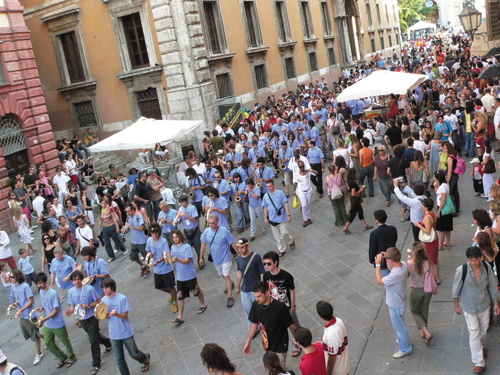
Students and others marched down Corso Vannucci in a parade to commemorate the passing of Charlie Parker 50 years ago.
This year the student musicians enrolled in the clinics came from all over Europe and from as far away as Australia, Canada, and the United States to study for two weeks with some of Berklee’s most respected faculty members. Occasionally jazz celebrities playing at the festival drop by the school. In past years, guest clinicians have included Elvin Jones, John McLaughlin, Joe Zawinul, Bobby McFerrin, and Wynton Marsalis. The program’s curriculum includes instrumental instruction, arranging classes, and ensembles. Everyone gets to sing or play in the final performances. Berklee scholarships are awarded at the last concert. Since the program began, Monroe says that nearly $2 million in tuition scholarships have been offered to the top students.
“We’ve had a lot of students in this program go on to do really well,” Monroe says. “There are 10 teaching assistants who interpret for us. A number of them began in the program, continued at Berklee, and now return each year to help us. Verve recording artist Chiara Civello [’98] was a student here for a couple of years. She won a scholarship and came to Berklee. Since graduating, she’s developed a nice career and was a featured performer at this year’s festival. She’s gone the full cycle from being a 16-year-old student at the clinics to an accomplished professional.”
While Monroe handles all the educational aspects of the program, Berklee Director of International Programs Sharon Glennon organizes and oversees all logistical details of Berklee’s participation in the festival, such as travel and accommodations, and helps create a special itinerary for those traveling with President Brown. This year’s guests received passes to all festival concerts, among other things.
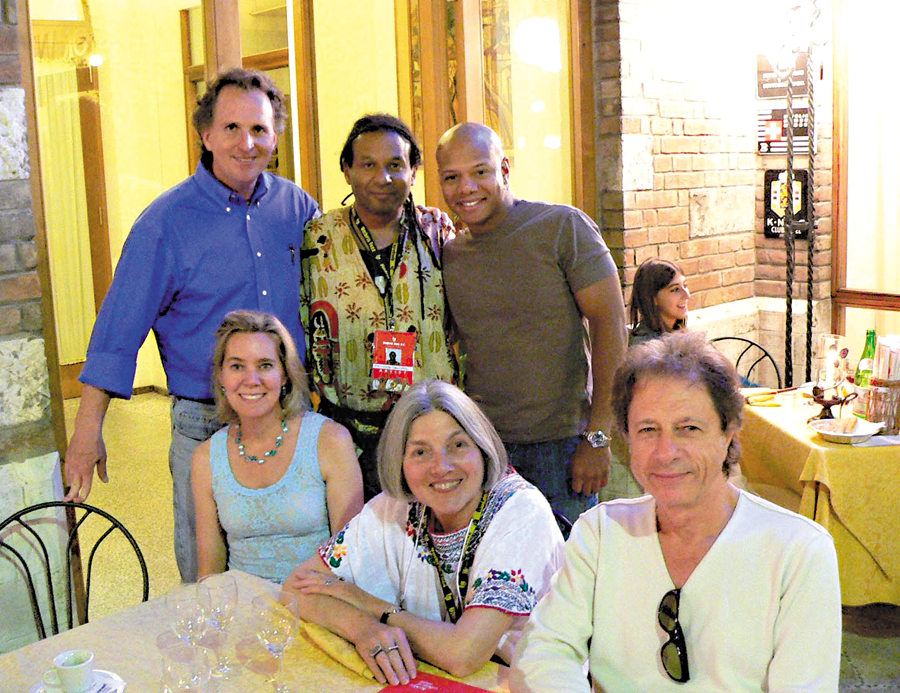
After dinner at La Rosetta. Clockwise from the left: Roger Brown, Kenwood Dennard, Mark Whitfield, Giovanni Tommaso, Collette Delerue, and Linda Mason.
“Initially, we’d planned tours of Assisi, Florence, and Spoleto, a cooking class, a guided tour of the city, and a hike in the countryside,” says Glennon. “The guests didn’t end up making any additional excursions though. I think the beauty, culture, and history of Perugia coupled with the museums, food, and music provided more than enough local interest for this year’s group. Maybe they’ll venture further a field next year. Everyone who’s gone on this trip wants to come back.”
“Jazz may have been invented somewhere along the Mississippi River,” says President Brown, “but one of the best places to enjoy it is at the Umbria Jazz Festival. The festival is among the best in the world, and the venues are unmatched. Berklee has helped educate some of Europe’s finest musicians in our clinics. I counted over 30 Berklee alumni and faculty here this year.”
“It will be a triple thrill for those who will come over here with Roger in future years,” says Monroe. “There’s the beauty and history of Perugia, music by some of the music world’s best musicians, and the Berklee presence here. Anyone can go the Umbria Jazz Festival; but when you go with us, you’re really in the midst of things surrounded by the musicians. I don’t know of any other situation where someone who comes as an audience member could get the taste of what it’s like to be a participant. This is a rare opportunity.”




